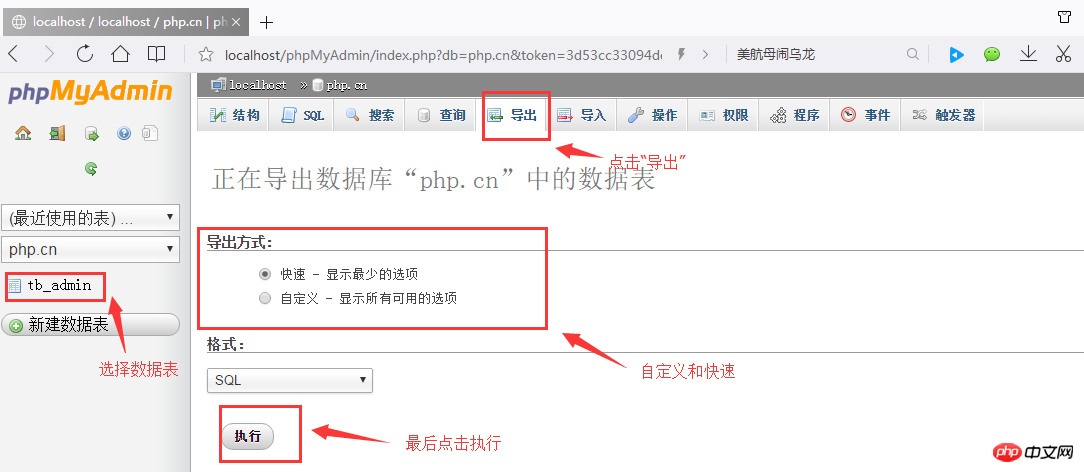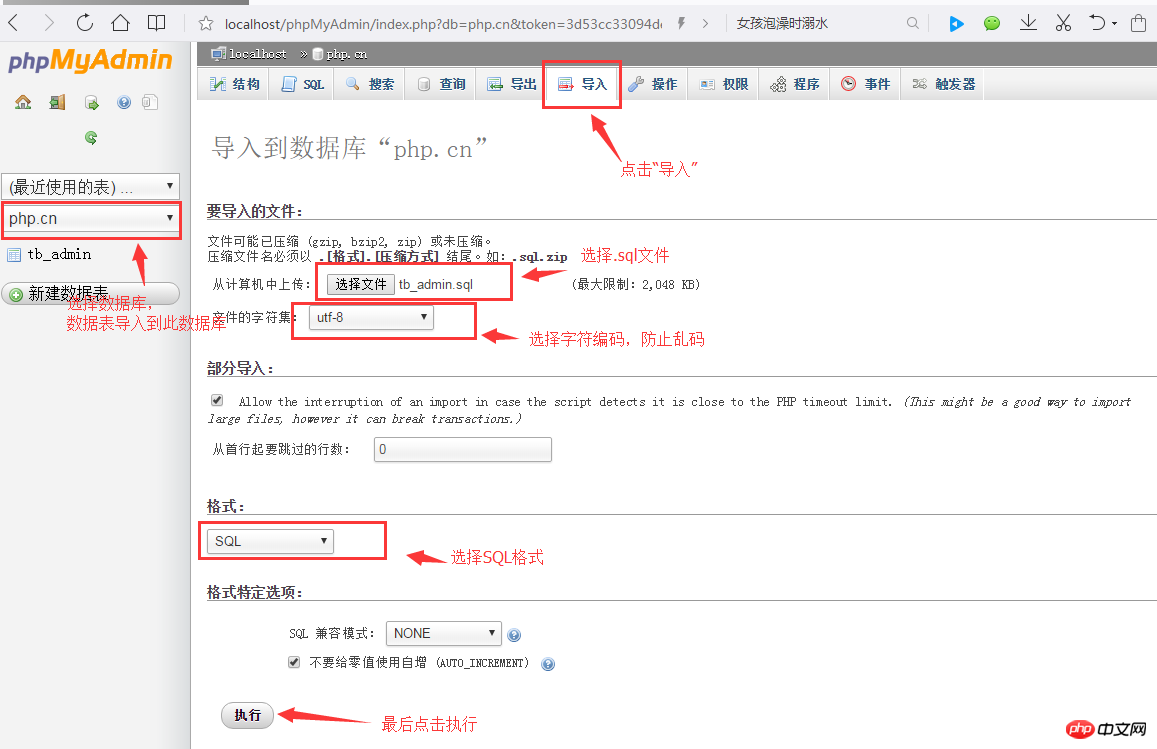 Database
Database
 Mysql Tutorial
Mysql Tutorial
 Graphical introduction to importing and exporting data tables (phpMyAdmin usage tutorial 5)
Graphical introduction to importing and exporting data tables (phpMyAdmin usage tutorial 5)
Graphical introduction to importing and exporting data tables (phpMyAdmin usage tutorial 5)
Graphical introduction to importing and exporting data tables (phpMyAdmin usage tutorial 5)
Importing and exporting data are two reciprocal operations. Import Data is imported into the database through files with the extension .sql. Exporting data stores the data table structure and table records as .sql files. Database backup and restore operations can be achieved through import and export. Below we will introduce the import and export methods respectively!
In the previous article " Detailed graphic explanation of managing data records (phpMyAdmin usage tutorial 4)" we introduced how to manage data, then we will introduce how to import and export data. !
1. Export data table
#First we need to select the data table or database to export. Here we take the export data table as an example. After selecting the data table, click the "Export" button in the navigation bar to enter the page for exporting data. There will be two options, "Quick" and "Custom" as shown below:

We usually directly select Quick, then select Format: SQL, and finally click Execute, and then save the location where the file is stored!
2. Import data table
First select the database, then click the "Import" button in the navigation bar to enter the import page. Then click the "Select File" button to find the location of the .sql file. The import file format is SQL. Click the "Execute" button to import the data table into the database, as shown below:

Note:
#Before importing the file, first ensure that there is a database with the same name as the imported database. If there is not one with the same name, Then you need to create a data table in the database with the same name as the database in the data file, and then import the data. In addition, in the current database, there cannot be a data table with the same name as the data table in the database to be imported. If there is a table with the same name, , importing the file will fail and an error message will be prompted.
Summary:
phpMyAdmin is a visual tool that provides MySQL database management and operation. It can easily manage MySQL database. By studying the contents of this chapter, friends can independently install and configure phpMyAdmin, and can use the visual tool phpMyAdmin to easily manage databases and data tables without creating bottlenecks in databases and data tables at the command prompt. For large websites, you can use import and export files to maintain the website database!
This is the end of the introduction on the use of phpMyAdmin visual tools. I believe that everyone has mastered it, so we will see you in the next topic!
【Related recommendations】
1. Relevant topic recommendations: "phpMyAdmin usage tutorial"
2. Related video courses Recommended: "MySQL Free Online Tutorial"
3. Online download of related tools: "phpMyAdmin Tool Download"
The above is the detailed content of Graphical introduction to importing and exporting data tables (phpMyAdmin usage tutorial 5). For more information, please follow other related articles on the PHP Chinese website!

Hot AI Tools

Undresser.AI Undress
AI-powered app for creating realistic nude photos

AI Clothes Remover
Online AI tool for removing clothes from photos.

Undress AI Tool
Undress images for free

Clothoff.io
AI clothes remover

AI Hentai Generator
Generate AI Hentai for free.

Hot Article

Hot Tools

Notepad++7.3.1
Easy-to-use and free code editor

SublimeText3 Chinese version
Chinese version, very easy to use

Zend Studio 13.0.1
Powerful PHP integrated development environment

Dreamweaver CS6
Visual web development tools

SublimeText3 Mac version
God-level code editing software (SublimeText3)

Hot Topics
 How to set primary key in phpmyadmin
Apr 07, 2024 pm 02:54 PM
How to set primary key in phpmyadmin
Apr 07, 2024 pm 02:54 PM
The primary key of a table is one or more columns that uniquely identify each record in the table. Here are the steps to set a primary key: Log in to phpMyAdmin. Select database and table. Check the column you want to use as the primary key. Click "Save Changes". Primary keys provide data integrity, lookup speed, and relationship modeling benefits.
 How to add foreign keys in phpmyadmin
Apr 07, 2024 pm 02:36 PM
How to add foreign keys in phpmyadmin
Apr 07, 2024 pm 02:36 PM
Adding a foreign key in phpMyAdmin can be achieved by following these steps: Select the parent table that contains the foreign key. Edit the parent table structure and add new columns in "Columns". Enable foreign key constraints and select the referencing table and key. Set update/delete operations. save Changes.
 Where does the wordpress database exist?
Apr 15, 2024 pm 10:39 PM
Where does the wordpress database exist?
Apr 15, 2024 pm 10:39 PM
The WordPress database is housed in a MySQL database that stores all website data and can be accessed through your hosting provider’s dashboard, FTP, or phpMyAdmin. The database name is related to the website URL or username, and access requires the use of database credentials, including name, username, password, and hostname, which are typically stored in the "wp-config.php" file.
 What is the password for the phpmyadmin account?
Apr 07, 2024 pm 01:09 PM
What is the password for the phpmyadmin account?
Apr 07, 2024 pm 01:09 PM
The default username and password for PHPMyAdmin are root and empty. For security reasons, it is recommended to change the default password. Method to change password: 1. Log in to PHPMyAdmin; 2. Select "privileges"; 3. Enter the new password and save it. When you forget your password, you can reset it by stopping the MySQL service and editing the configuration file: 1. Add the skip-grant-tables line; 2. Log in to the MySQL command line and reset the root password; 3. Refresh the permission table; 4. Delete skip-grant-tables line, restart the MySQL service.
 Where is the phpmyadmin log?
Apr 07, 2024 pm 12:57 PM
Where is the phpmyadmin log?
Apr 07, 2024 pm 12:57 PM
Default location for PHPMyAdmin log files: Linux/Unix/macOS:/var/log/phpmyadminWindows: C:\xampp\phpMyAdmin\logs\ Log file purpose: Troubleshooting Audit Security
 How to delete data table in phpmyadmin
Apr 07, 2024 pm 03:00 PM
How to delete data table in phpmyadmin
Apr 07, 2024 pm 03:00 PM
Steps to delete a data table in phpMyAdmin: Select the database and data table; click the "Action" tab; select the "Delete" option; confirm and perform the deletion operation.
 How to import local songs from NetEase Cloud Music How to import local songs
Mar 13, 2024 am 11:19 AM
How to import local songs from NetEase Cloud Music How to import local songs
Mar 13, 2024 am 11:19 AM
When we use this platform to listen to songs, most of them should have some songs that you want to listen to. Of course, some things may not be listened to because there is no copyright. Of course, we can also directly use some songs imported locally. Go up there so you can listen. We can download some songs and directly convert them into mp3 formats, so that they can be scanned on the mobile phone for import and other situations. However, for most users, they don’t know much about importing local song content, so in order to solve these problems well, today the editor will also explain it to you. The content method allows you to make better choices without asking. If you are interested,
 why phpmyadmin access denied
Apr 07, 2024 pm 01:03 PM
why phpmyadmin access denied
Apr 07, 2024 pm 01:03 PM
Reasons and solutions for access denied by phpMyAdmin: Authentication failed: Check whether the username and password are correct. Server configuration error: adjust firewall settings and check whether the database port is correct. Permissions issue: Granting users access to the database. Session timeout: Refresh the browser page and reconnect. phpMyAdmin configuration error: Check the configuration file and file permissions to make sure the required Apache modules are enabled. Server issue: Wait for a while and try again or contact your hosting provider.





